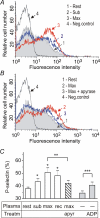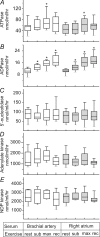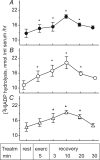Intravascular ADP and soluble nucleotidases contribute to acute prothrombotic state during vigorous exercise in humans
- PMID: 17204504
- PMCID: PMC2075398
- DOI: 10.1113/jphysiol.2006.119453
Intravascular ADP and soluble nucleotidases contribute to acute prothrombotic state during vigorous exercise in humans
Abstract
Extracellular ATP and ADP trigger vasodilatatory and prothrombotic signalling events in the vasculature. Here, we tested the hypothesis that nucleotide turnover is activated in the bloodstream of exercising humans thus contributing to the enhanced platelet reactivity and haemostasis. Right atrial, arterial and venous blood samples were collected from endurance-trained athletes at rest, during submaximal and maximal cycle ergometer exercise, and after early recovery. ATP-specific bioluminescent assay, together with high-performance liquid chromatographic analysis, revealed that plasma ATP and ADP concentrations increased up to 2.5-fold during maximal exercise. Subsequent flow cytometric analysis showed that plasma from exercising subjects significantly up-regulated the surface expression of P-selectin in human platelets and these prothrombotic effects were diminished after scavenging plasma nucleotides with exogenous apyrase. Next, using thin layer chromatographic assays with [gamma-(32)P]ATP and (3)H/(14)C-labelled nucleotides, we showed that two soluble nucleotide-inactivating enzymes, nucleotide pyrophosphatase/phosphodiesterase and nucleoside triphosphate diphosphohydrolase, constitutively circulate in human bloodstream. Strikingly, serum nucleotide pyrophosphatase and hydrolase activities rose during maximal exercise by 20-25 and 80-100%, respectively, and then declined after 30 min recovery. Likewise, soluble nucleotidases were transiently up-regulated in the venous blood of sedentary subjects during exhaustive exercise. Human serum also contains 5'-nucleotidase, adenylate kinase and nucleoside diphosphate (NDP) kinase; however, these activities remain unchanged during exercise. In conclusion, intravascular ADP significantly augments platelet activity during strenuous exercise and these prothrombotic responses are counteracted by concurrent release of soluble nucleotide-inactivating enzymes. These findings provide a novel insight into the mechanisms underlying the enhanced risk of occlusive thrombus formation under exercising conditions.
Figures






References
-
- Atkinson B, Dwyer K, Enjyoji K, Robson SC. Ecto-nucleotidases of the CD39/NTPDase family modulate platelet activation and thrombus formation: Potential as therapeutic targets. Blood Cells Mol Dis. 2006;36:217–222. - PubMed
-
- Belayev L, Khoutorova L, Deisher TA, Belayev A, Busto R, Zhang Y, Zhao W, Ginsberg MD. Neuroprotective effect of SolCD39, a novel platelet aggregation inhibitor, on transient middle cerebral artery occlusion in rats. Stroke. 2003;34:758–763. - PubMed
-
- Birk AV, Broekman MJ, Gladek EM, Robertson HD, Drosopoulos JH, Marcus AJ, Szeto HH. Role of extracellular ATP metabolism in regulation of platelet reactivity. J Laboratory Clin Med. 2002;140:166–175. - PubMed
Publication types
MeSH terms
Substances
LinkOut - more resources
Full Text Sources
Medical
Research Materials

